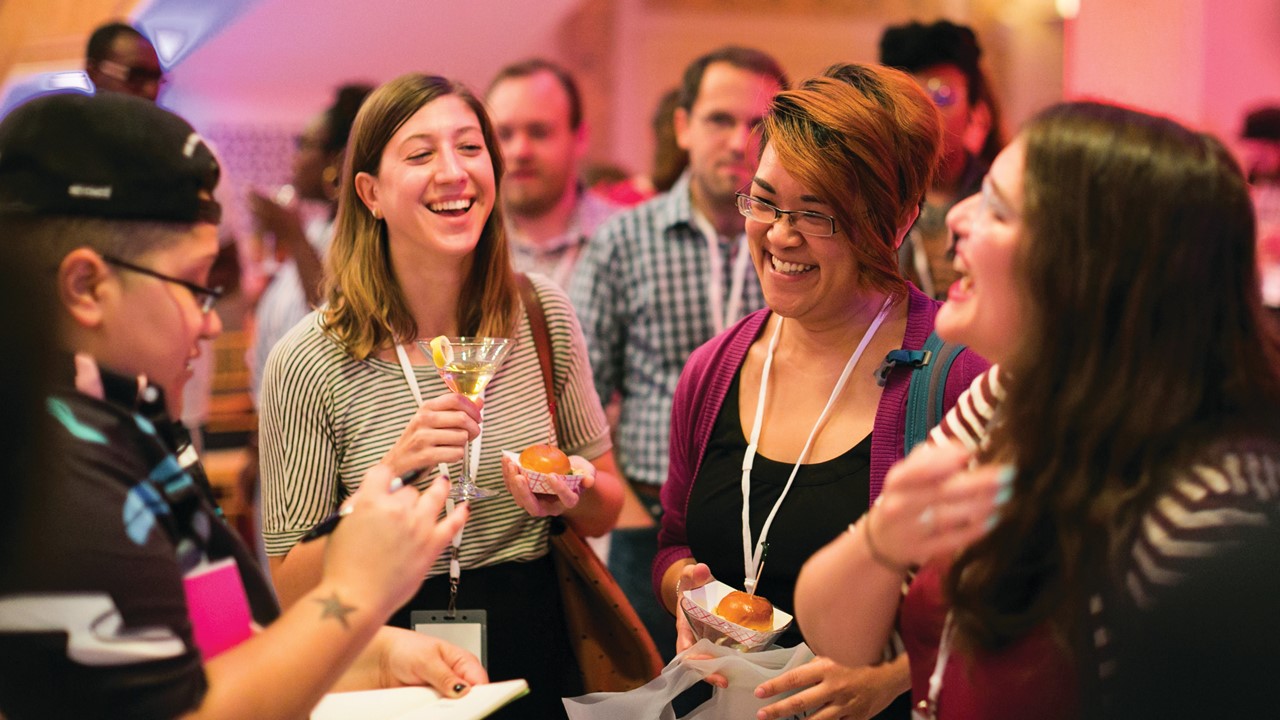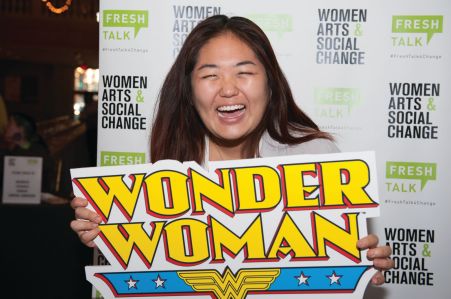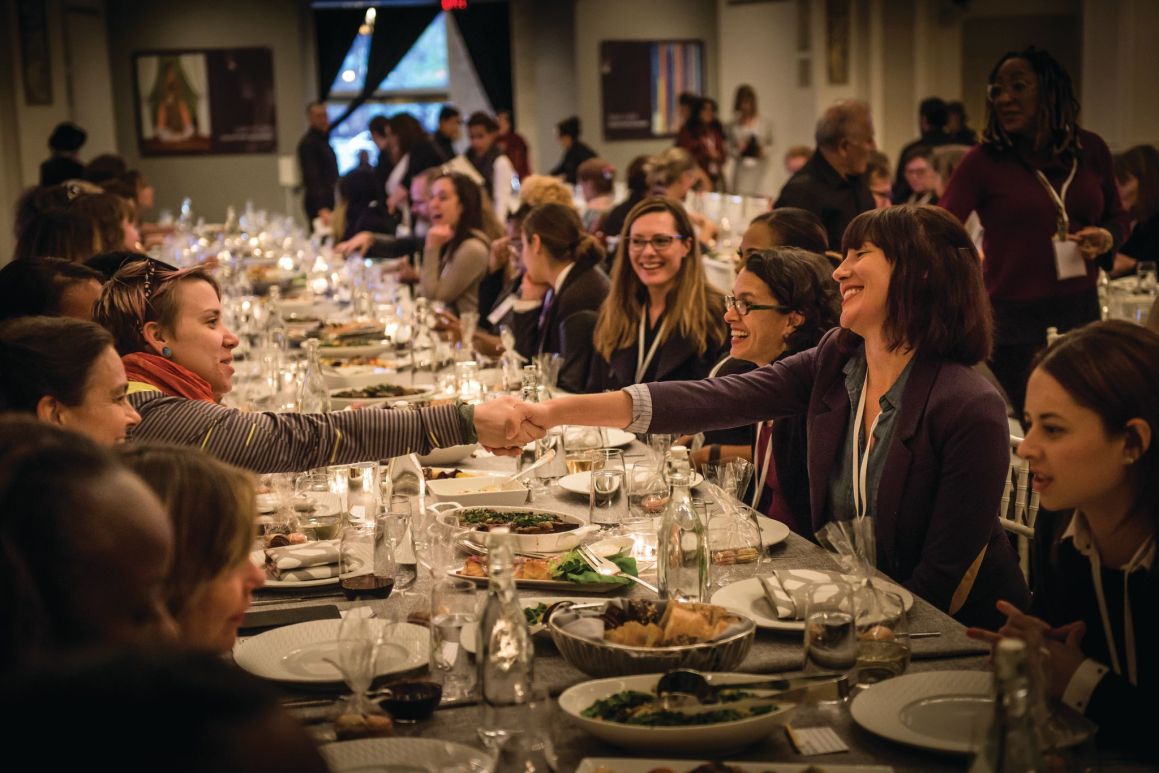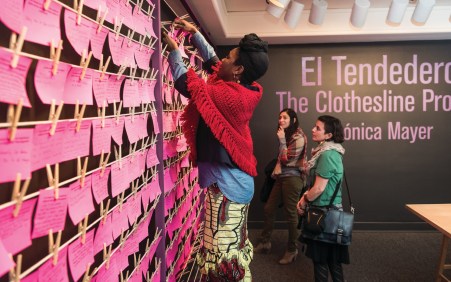
The National Museum of Women in the Arts’ “Fresh Talk” series gives breath and breadth to bold ideas about the interplay among women, art, and social change.
This article originally appeared in the March/April 2020 issue of Museum magazine, a benefit of AAM membership.
What happens when a museum becomes a hub for socially engaged conversation? This is a question the National Museum of Women in the Arts (NMWA) is answering.
In Washington, DC, NMWA has established itself as a center for the exchange of ideas at the intersection of women, arts, and social change. The museum’s public programs gather diverse audiences, foster dialogue, and build connection around a range of social topics and issues.
Specifically, NMWA’s Women, Arts, and Social Change (WASC) initiative focuses on women and the arts as catalysts for change. Public programs offer a platform for speakers and attendees to advance ideas to address society’s most pressing issues—especially those affecting women—and inspire action in the arts and beyond.
As museums everywhere reimagine how they can engage local communities in meaningful ways, WASC is a model that is working.
Connecting Around Social Engagement
The museum introduced WASC in 2015 as its signature public programs initiative focused on highlighting the power of women and the arts to create meaningful change. The initiative’s Fresh Talk series convenes prominent women in the arts with change makers outside the field for creative conversations on art, gender, equity, the environment, identity, education, health, social and economic opportunity, and more.

Speakers are carefully selected—and have included artists Carrie Mae Weems and Ann Hamilton, poet Nikki Giovanni, artist and activist Emma Sulkowicz, curator and bestselling author Sarah Lewis, Tate Modern Director Frances Morris, and many more—but the conversations are open and honest.
“By allowing speakers a platform to express ideas from their place of practice and expertise, we’re creating room for real conversations to take place,” says NMWA Director of Public Programs Melani N. Douglass. “We work to diversify the voices at the table. Since DC is a city with both local and global reach, we can create space for people who think or work globally to connect locally.”
Post-event communal suppers and interactive cocktail hours help foster these connections. Inspired by the on-stage conversation, attendees gather to play games, write poetry, or make a craft. These activities spark engagement around the evening’s topic.
“Institutions are, understandably, reluctant to create platforms that amplify speakers with bold ideas and calls for change,” Douglass says. “However, what will museums become if we are not sites where challenging conversations can happen? We have to remember who we serve and what we want our audience to know about us.”
In the four years since the first Fresh Talk, nearly every program has sold out. An average of about 20 percent of attendees are first-time visitors. Attendees unanimously say that they have a better understanding of the museum’s mission to champion women through the arts as a result of attending a Fresh Talk program.
“When we created the Women, Arts, and Social Change initiative, we wanted to present programs that reflected who we are as an institution—a museum that redefines what it means to advocate for art and artists,” says NMWA Director Susan Fisher Sterling. “Since then, we have built an innovative, talented, and solution-oriented community comprising 60 outstanding presenters and nearly 7,500 participants who vary by age, occupation, gender, economics, educational level, culture, and outlook.”
Sterling sees the programs as a natural extension of current conversations around socially engaged art, in which an artist’s practice involves creating work that addresses a social or political issue and aspires to empower change. In fact, women artists have been at the forefront of socially engaged art—but are often relegated to showing their work in spaces outside the traditional art market.
For example, Mother Art, a collective of women artists in the 1970s and ’80s, was dedicated to creating social-political art through installation and performance in non-traditional spaces, including laundromats, stores, and conferences. Ntozake Shange’s renowned theater piece For Colored Girls… was initially performed in bars. Faith Ringgold used the mural format to respond to disparities between black and white people during the civil rights era. Harmony Hammond, whose cloth-based sculptures probe issues related to class, was a founding member of New York’s A.I.R. Gallery, the nation’s first artist-run nonprofit gallery for women, which opened in 1972 as an alternative to mainstream institutions.
Today, socially engaged artists confront a broad range of urgent topics affecting women and girls around the world, from climate change and racism to misogyny and rape culture.
Turning a Legacy into a Program
Reflecting on this rich legacy of arts activism, museum staff sought to translate it into public programming. They decided to start the series by looking inward. The first Fresh Talk, “Righting the Balance—Can there be gender parity in the arts?,” faced the art world’s gender inequity head-on. Artists, curators, critics, and representatives of auction houses and galleries were paired with activists, social media entrepreneurs, and researchers to consider strategies in the quest for gender equity.
In later programs, the topic expanded. “Righting the Balance—How can the arts advance body politics?” explored how the arts might address issues of discrimination, sexism, and sexual violence. But instead of a cadre of visual artists, a group of activists, filmmakers, and writers framed the discussion.
Other programs affirmed the series’ commitment to fostering cross-disciplinary conversations and an expanded definition of art. Scientists and engineers discussed ways that technological innovations can heal the environment. Female comic book writers and illustrators discussed gender roles in superhero tales. Douriean Fletcher, the jewelry designer for the film Black Panther, talked with anthropologist Ayana Flewellen and Maia Nuku, a curator from the Metropolitan Museum of Art, about the ways adornment communicates gender and power. One evening was devoted to the bicycle, with experts discussing its impact on women’s mobility and empowerment.
Museum staff continue to experiment with program formats in a quest for deeper, long-term audience engagement. Mexico City-based artist Mónica Mayer came to the museum with her bilingual, participatory installation “El Tendedero/The Clothesline Project.” The artist transformed the clothesline into a tool to facilitate dialogue around women’s experiences with gender-based violence. Mayer’s visits included community-based workshops and culminated in a Fresh Talk.
In fall 2020, NMWA will present “Reclamation: Recipes, Remedies, and Rituals,” a project consisting of a series of talks, workshops on the connections between food and art, and a participatory food-related exhibition. The programming explores how traditionally feminine roles in the family, home, and community powerfully intersect with ethnic and ancestral identities.
The Fresh Talk programs are produced internally by a team of two with the help of a program fellow, an intern, and a core group of volunteers. Partnerships—like with Together We Bake, a bakery in nearby Alexandria, Virginia, that employs former prisoners—enhance the programs.
Fresh Talk topics are informed primarily by current events, and though planning is done months in advance, staff members keep tabs on relevant hot-button issues and the women who are addressing them. In selecting speakers, Douglass looks to experts in their fields but also at personalities, aiming for a mixture of introverts and extroverts to keep talks balanced. The speakers usually have dinner before the program so they can get to know each other before their public conversation.

Encouraging a State of Query
Audience reactions are enthusiastic and generally positive—but Fresh Talk conversations also prompt attendees to consider new perspectives, ask questions, and, on occasion, get introspective.
“This changed my opinion that I am experiencing challenges that no one else is. We are all going through some struggles,” said one attendee. “The women on the panel said a lot of things that were new to me and that I needed to hear,” said another. Many indicate a desire to make a change in their own lives: “I’m inspired to start taking a more critical eye in my corporate creative work to promote and ensure diversity has a priority.” The Fresh Talk was “inspirational and gives me more energy to become more socially active,” said another. Others described feeling uncomfortable during the programs—which staff members view as a good thing.
“My goal is for 10 percent of the audience to feel like they are aligned with the views expressed, 10 percent to feel uncomfortable and shaken, and 80 percent to be in state of query—challenged or excited about the content and rethinking what museums can be,” Douglass says. “Success is determined by our ability to present the conversation in a way that keeps everyone at the table, engaged, and willing to add their voice.”

In starting the Fresh Talk series, staff decided early on that attendance and income would not be the key determinates for success. The ticket prices (typically $20–$25) are intentionally low, especially for programs that include dinner and drinks, to minimize barriers to entry. Fresh Talk programs are inclusive and have been invaluable in shifting public perception of the museum—an institution with open doors, where anyone can take a seat at the table.
Fresh Talk events are live-streamed and recorded and available online shortly after each presentation. Audiences at NMWA and beyond are invited to add their voices via social media using #freshtalk4change.
“If the art is important, then the conversations that inspired the art are just as important,” Douglass says. “Museums must be spaces where artists and change agents can come together and speak freely. Our programs resonate with our audience because the framework supports the expression of bold ideas and tough conversations.”
Keys to Success
Following are some things the National Museum of Women in the Arts (NMWA) has learned over the four years that the Women, Arts, and Social Change (WASC) initiative has existed.
- Diverse voices are essential. Museum staff seek out different viewpoints and personalities, asking who needs to be in the room to encourage a compelling conversation.
- Institutional buy-in is vital. Many museum departments contribute to the WASC initiative. Spearheaded by a team of two, museum staff are able to act quickly to respond to current events and have the support to make timely decisions.
- Markers for success go beyond attendance and income. While the WASC programs took some time to become established, they have been instrumental in shaping public perceptions of the museum. Attendees say the program gives them a better understanding of the museum’s mission to champion women through the arts.
Resources
To view Fresh Talk videos, please visit nmwa.org/freshtalk4change.
Visit Get the Facts for more information about gender equity in the arts: nmwa.org/advocate/get-facts.
Emma Filar is the communications and marketing manager for the National Museum of Women in the Arts in Washington, DC.







